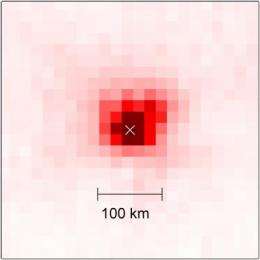September 23, 2011 report
Most accurate measurements of big-city pollution

(PhysOrg.com) -- One of NASA's satellites has provided the most detailed map yet of the pollution generated by some of the world’s biggest cities, and given an indication of the volume of emissions of the nitrogen oxides from direct measurements rather than relying on computer models and a range of assumptions.
The scientists, from Germany and the Netherlands, led by Steffen Beirle of the Max Planck Institute for Chemistry in Mainz, Germany, combined the data from NASA’s Aura satellite with data on known wind patterns. The satellite is equipped with four measuring instruments, including an Ozone Monitoring Instrument (OMI), which measures a range of atmospheric particles such as dust, smoke, and chemicals such as the nitrogen oxides. It also measures cloud cover and pressure, which enables tropospheric ozone to be calculated. The OMI was built by the Agency for Aerospace Programs in the Netherlands and the Finnish Meteorological Institute.
The focus of Beirle’s study was the nitrogen oxides (NOx, comprising nitric oxide, NO, and nitrogen dioxide, NO2), since they contribute to smog, acid rain, and ozone depletion, and have been linked to health problems in human populations.
Nitrogen oxides form part of vehicle emissions, and in the past have tended to be estimated from data on traffic volumes, fuel consumption, and NOx lifetimes, rather than by direct measurement. The satellite data gave the researchers a direct measurement of the emissions, and the data on wind patterns enabled them to identify the sources, resulting in the most accurate information available to date.
The study, published in the journal Science, found that the emissions of nitrogen oxides from Riyadh (the capital of Saudi Arabia) were three times greater than previous estimates, while those of megacities such as Tokyo, Madrid, and Moscow were more similar to previous estimates. Some megacities, such as Hong Kong and New York, yielded less useful data because they are so close to other large metropolitan areas producing pollution, which makes the situation more complex.
The results of the research could help scientists obtain more reliable information that does not depend on models, which can introduce biases. The results could also lead to the development of better pollution control measures, especially for large cities in the developing world.
The Aura satellite was launched in 2004 as part of a program aimed at monitoring the Earth’s atmosphere and effects such as the depletion of the ozone layer. Among the other atmospheric measurements made are changes in levels of aerosols, carbon dioxide, water vapor, and methane. The satellite also monitors cloud cover around the globe.
More information: aura.gsfc.nasa.gov/
Paper: Megacity Emissions and Lifetimes of Nitrogen Oxides Probed from Space, Science 23 September 2011: Vol. 333 no. 6050 pp. 1737-1739. DOI: 10.1126/science.1207824
Abstract
Megacities are immense sources of air pollutants, with large impacts on air quality and climate. However, emission inventories in many of them still are highly uncertain, particularly in developing countries. Satellite observations allow top-down estimates of emissions to be made for nitrogen oxides (NOx = NO + NO2), but require poorly quantified a priori information on the NOx lifetime. We present a method for the simultaneous determination of megacity NOx emissions and lifetimes from satellite measurements by analyzing the downwind patterns of NO2 separately for different wind conditions. Daytime lifetimes are ~4 hours at low and mid-latitudes, but ~8 hours in wintertime for Moscow. The derived NOx emissions are generally in good agreement with existing emission inventories, but are higher by a factor of 3 for the Saudi Arabian capital Riyadh.
© 2011 PhysOrg.com

















